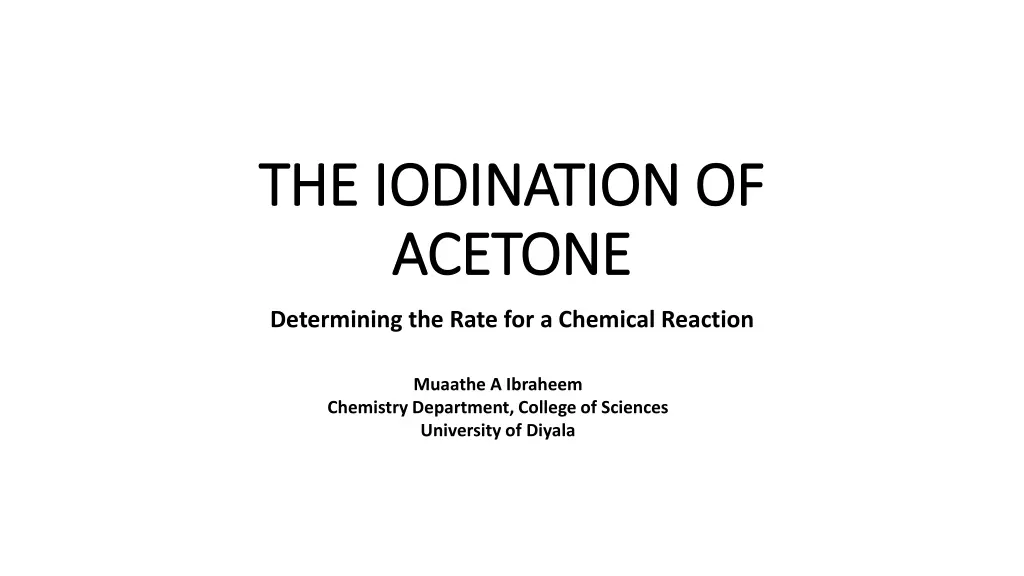
Determining the Rate Constant of Iodination of Acetone Reaction
Explore the zero-order reaction of the iodination of acetone experiment, determining rate constants, and analyzing reaction parameters such as concentration and temperature. Follow the detailed procedure outlined for accurate results.
Download Presentation

Please find below an Image/Link to download the presentation.
The content on the website is provided AS IS for your information and personal use only. It may not be sold, licensed, or shared on other websites without obtaining consent from the author. If you encounter any issues during the download, it is possible that the publisher has removed the file from their server.
You are allowed to download the files provided on this website for personal or commercial use, subject to the condition that they are used lawfully. All files are the property of their respective owners.
The content on the website is provided AS IS for your information and personal use only. It may not be sold, licensed, or shared on other websites without obtaining consent from the author.
E N D
Presentation Transcript
THE IODINATION OF THE IODINATION OF ACETONE ACETONE Determining the Rate for a Chemical Reaction Muaathe A Ibraheem Chemistry Department, College of Sciences University of Diyala
Theory Rate of reaction depend on several parameter includes concentration, temperature the nature of the reaction. In this experiment it will be determined the rate constant of the reaction between Iodine and acetone. The reaction can be describe as the below chemical equation ?+ ??3????3+ ?2 ??3????2? + ??
Zero order reaction The reaction can be catalzed by both an acid or alkali reagent . The reaction can be considered as a self catalzed reaction as an acid is produced to reaction and HI is a product. The reaction is classified as a zero order reaction. The rates of a zero-order reactions do not vary with increasing nor decreasing reactants concentration in other word its constant with time and it is independent of the reactants concentration. This can be expressed in the equation below ?? ??= ? = ? ??3????3 ??2 ??+ ?
As the concentration of H+ is constant in the reaction them, the former equation can be rewrite to be ? = ? ??3????3 ??2 ? The amount of acetone is large and would not effect noticeably so it can be neglected then the concentration of acetone from the above equation can be ignored and it will be as ? = ? ?2 ? Finally, it found Iodine will not affect the rate of reaction and the final reaction ? = ?
By integrated the last equation we will get very simple linear equation as below which can be rearranged to be 7 6 Slope= k ?? ??= ? .(1) 5 4 ?? = ? ??=? X ? .(2) 3 2 1 Equation 2 now can be draw as graph as . The half time reaction is then 0 0 2 4 6 8 can be determine from equation (3) ? 2?? time ? 1 2= .(3)
Procedure Determination A the initial concentration 1. In volumetric flask of 50ml transfer 12.5ml of 0.1 M of Iodine solution, the add 10ml of (0.1M) H2SO4 and complete the volume with distilled water to the mark. Take 10 ml of the above mix and transfer it to a conical flask and add (0.1M) of Sodium acetate to stope the reaction the add starch solution The colour will be blue . Then titrate the mixture against (0.1M) sodium thiosulphate Till the colour will be disappeared; now use the equation 2. M1V1=M2V2 to calculate the A Value. Determination A-X value 3. Make the same mixture of step 1 but add 12.5 ml of acetone at this point start the clock stop to account the time of the reaction, then complete the volume with distilled water to the mark 4. After 5 min draw 5 ml from the mixture and add again 10ml of (0.1M) Sodium acetate before the titration against sodium thiosulphate solution. Repeat this step in parodical time (every 5 min)
Results and calculation T min Vo= a Vt = (a-x) X=a-(a-x) 5 Arrange the result in table like this Draw the X ( y axis) against Time Determin the slope which represent K value Finally determine the t1/2 10 15 20 25 Note: A 0.1M of Iodine solution is prepared from dissolving a 20g of KI and 23.58g of Iodine in 1 litter distilled water
